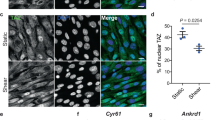Abstract
Fluidic shear stress applied to epithelial cells inside the kidney tubules affects cell size in an autophagy-related manner. Here, we describe the technical equipment that we routinely use to apply shear stress on cells, as well as immunoblotting, immunofluorescence, and three-dimensional cell volume reconstruction techniques used in analysis of the influence of this stress on cells and cellular components. By pointing out details of experimental techniques and potential pitfalls, this review will serve as a guide for those interested in study of how shear stress influences cells.
Access this chapter
Tax calculation will be finalised at checkout
Purchases are for personal use only
Similar content being viewed by others
References
Boya P, Reggiori F, Codogno P (2013) Emerging regulation and functions of autophagy. Nat Cell Biol 15(7):713–720
Mizushima N, Komatsu M (2011) Autophagy: renovation of cells and tissues. Cell 147(4):728–741
Morel E, Mehrpour M, Botti J, Dupont N, Hamai A, Nascimbeni AC, Codogno P (2017) Autophagy: a druggable process. Annu Rev Pharmacol Toxicol 57:375–398
Mammoto T, Mammoto A, Ingber DE (2013) Mechanobiology and developmental control. Annu Rev Cell Dev Biol 29:27–61
Baeyens N, Bandyopadhyay C, Coon BG, Yun S, Schwartz MA (2016) Endothelial fluid shear stress sensing in vascular health and disease. J Clin Invest 126(3):821–828
Orhon I, Dupont N, Zaidan M, Boitez V, Burtin M, Schmitt A, Capiod T, Viau A, Beau I, Wolfgang Kuehn E, Friedlander G, Terzi F, Codogno P (2016) Primary-cilium-dependent autophagy controls epithelial cell volume in response to fluid flow. Nat Cell Biol 18(6):657–667
Praetorius HA (2015) The primary cilium as sensor of fluid flow: new building blocks to the model. A review in the theme: cell signaling: proteins, pathways and mechanisms. Am J Physiol Cell Physiol 308(3):C198–C208
Raghavan V, Weisz OA (2016) Discerning the role of mechanosensors in regulating proximal tubule function. Am J Physiol Renal Physiol 310(1):F1–F5
Yamamoto A, Tagawa Y, Yoshimori T, Moriyama Y, Masaki R, Tashiro Y (1998) Bafilomycin A1 prevents maturation of autophagic vacuoles by inhibiting fusion between autophagosomes and lysosomes in rat hepatoma cell line, H-4-II-E cells. Cell Struct Funct 23(1):33–42
Klionsky DJ, Elazar Z, Seglen PO, Rubinsztein DC (2008) Does bafilomycin A1 block the fusion of autophagosomes with lysosomes? Autophagy 4(7):849–950
Klionsky DJ, Abdalla FC, Abeliovich H, Abraham RT, Acevedo-Arozena A, Adeli K, Agholme L, Agnello M, Agostinis P, Aguirre-Ghiso JA, Ahn HJ, Ait-Mohamed O, Ait-Si-Ali S, Akematsu T, Akira S et al (2012) Guidelines for the use and interpretation of assays for monitoring autophagy. Autophagy 8(4):445–544
Rubinsztein DC, Cuervo AM, Ravikumar B, Sarkar S, Korolchuk V, Kaushik S, Klionsky DJ (2009) In search of an “autophagomometer”. Autophagy 5(5):585–589
Dupont N, Leroy C, Hamai A, Codogno P (2017) Long-lived protein degradation during autophagy. Methods Enzymol 588:31–40
Klionsky DJ, Abdelmohsen K, Abe A, Abedin MJ, Abeliovich H, Acevedo Arozena A, Adachi H, Adams CM, Adams PD, Adeli K, Adhihetty PJ, Adler SG, Agam G, Agarwal R, Aghi MK et al (2016) Guidelines for the use and interpretation of assays for monitoring autophagy (3rd edition). Autophagy 12(1):1–222
Acknowledgments
Work in the Codogno laboratory is supported by funding from INSERM, CNRS, and Université Paris-Descartes-Sorbonne Paris Cité and by grants from INCa and ANR. M.L. and I.O. are supported by an ERASMUS internship and a FEBS postdoctoral fellowship, respectively.
Author information
Authors and Affiliations
Corresponding authors
Editor information
Editors and Affiliations
Rights and permissions
Copyright information
© 2019 Springer Science+Business Media, LLC, part of Springer Nature
About this protocol
Cite this protocol
Lazari, M.M., Orhon, I., Codogno, P., Dupont, N. (2019). Monitoring of Autophagy and Cell Volume Regulation in Kidney Epithelial Cells in Response to Fluid Shear Stress. In: Ktistakis, N., Florey, O. (eds) Autophagy. Methods in Molecular Biology, vol 1880. Humana Press, New York, NY. https://doi.org/10.1007/978-1-4939-8873-0_22
Download citation
DOI: https://doi.org/10.1007/978-1-4939-8873-0_22
Published:
Publisher Name: Humana Press, New York, NY
Print ISBN: 978-1-4939-8872-3
Online ISBN: 978-1-4939-8873-0
eBook Packages: Springer Protocols




